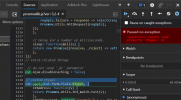Thank you Thomas, there just seems to be a few things people are complaining about not working.
With the flexibility of Proxmox VE, the wide range of different hardware, changing software (be it ours or the one actually running in the virtual guests) and big differences in the needs of users there always will be some complaints about issues in a wider sense (bugs, enhancement request, setup/configuration troubles, ...)

Fact is that we already see many tens of thousands of accesses from different systems on our Proxmox VE 7.x Bullseye repo infrastructure, compared to the count of problem-posts that does not seem like an outstanding amount of noticeable issues. To clarify, I'm certainly not saying that there are none issue whatsoever, just that there are not significantly more than any other release (e.g., 6.4) has, and that we already fixed or actively work on known and reproducible ones, like we always try to do.
It took a while and some 3rd party patches to get things almost perfect the last time around but now I am starting again, so was just wondering if I should go with the tried and tested.
What 3rd party patches do you need? And where, the kernel? If you have such patches applied it'd surely be worth it to first test an upgrade on test hardware, if possible, as we obviously cannot test any imaginable 3rd party patch.
Usually first released of most things will have bugs.
FWIW: All but the most trivial software have bugs, but yes you're right in that any new, and especially bigger, release can contain new bugs, sometimes only affecting certain setups. That's why we recommend testing out any newer release before upgrading important production service. Ideally using similar HW than the actual setup(s), or at least doing so in a virtual setup, modelled after the actual setup as close as possible.
I always thought, although based on Debian, Proxmox follows Ubuntu kernel and updates, meaning it won’t freeze the same way as Debian.
We only base off the Ubuntu Kernel, albeit with a few patches on top and our own release; mostly as we want a bit more recent kernel releases that Debian provides for improved HW support, but also because (server) HW certification exists already for the Ubuntu kernel. The remaining packages are coming either from ours (core PVE packages) or Debian's repositories.
Obviously you can tell I’m a Linux noob so just asking questions before my rebuild

I honestly cannot really tell that, but answering the question would need some more specific details about your setup, like the ones about 3rd party patches asked above. It would probably be better to post that and the concerns you have in its own thread to avoid crowding the more general release thread.


